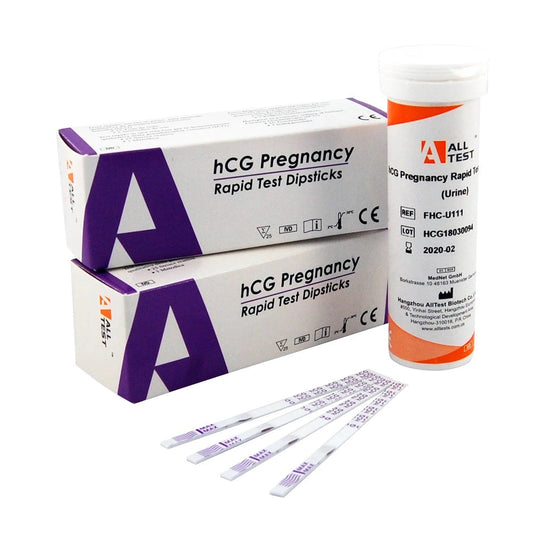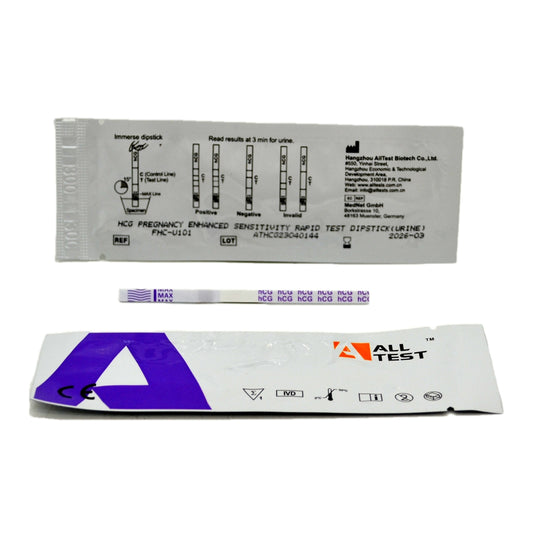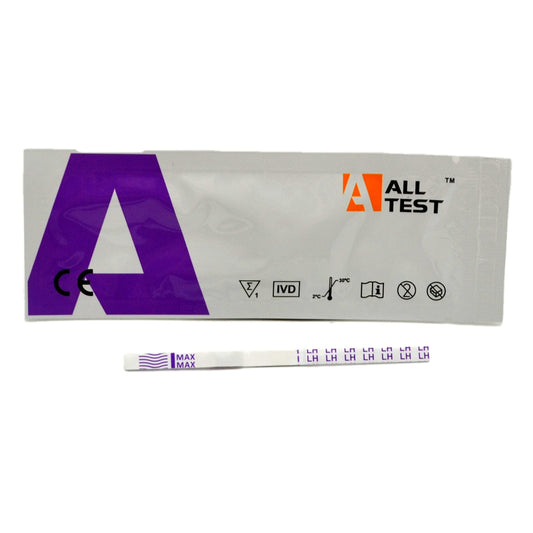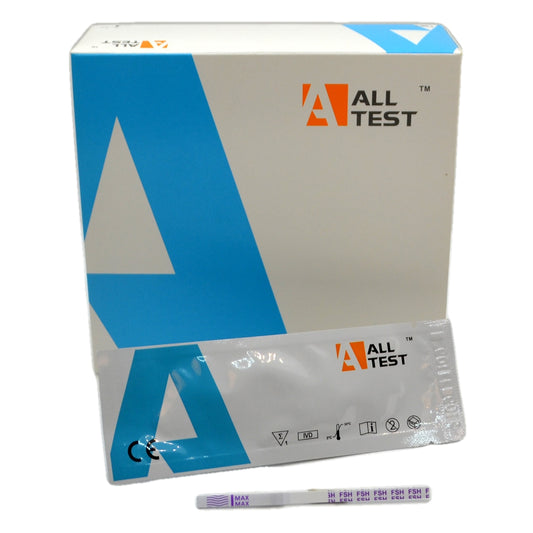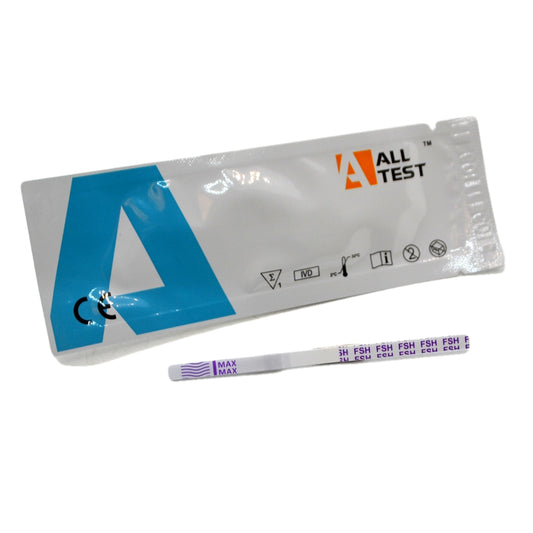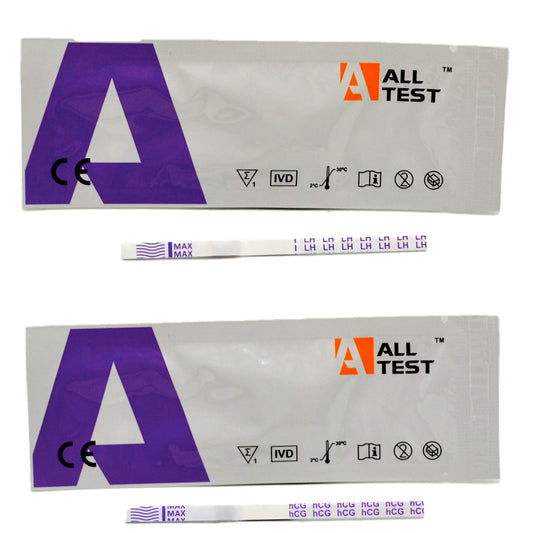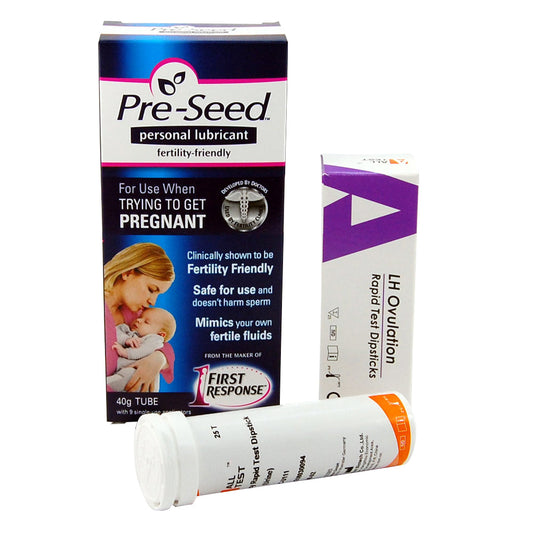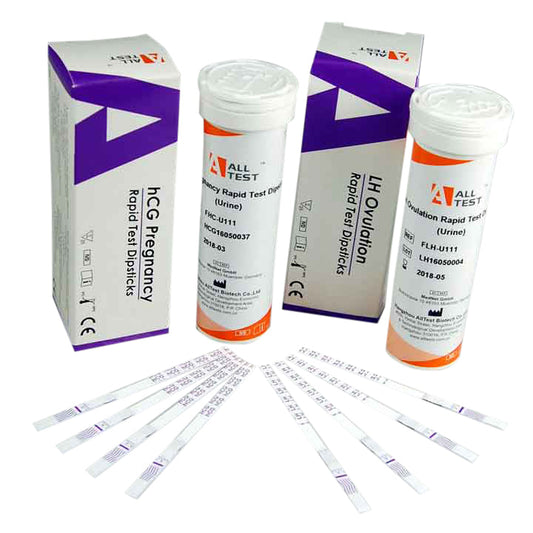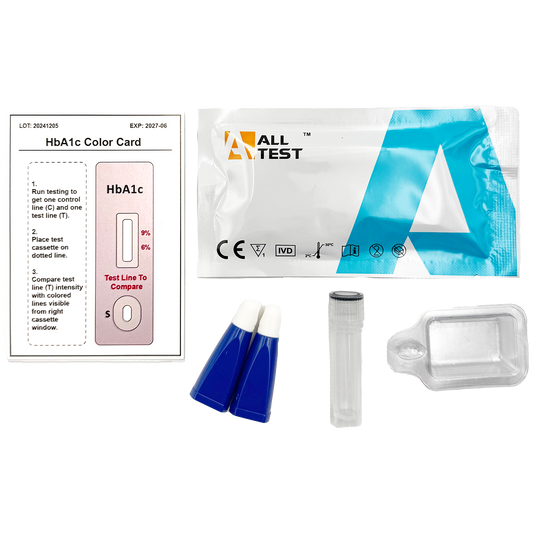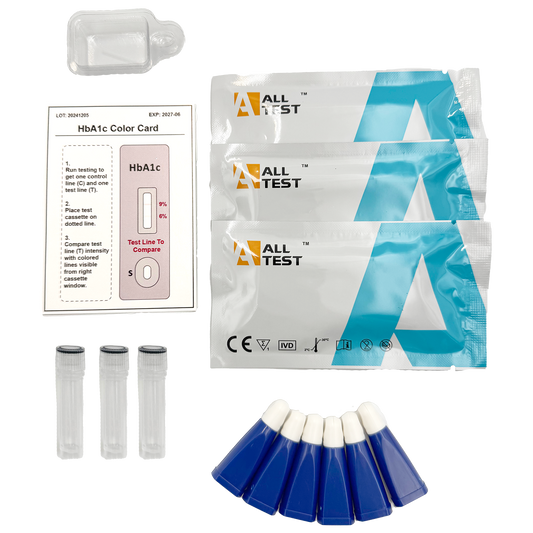Collection: Best Sellers
These are our best selling fertility products, fertility lubricants, fertility tests, ovulation tests and early detection pregnancy tests this month.
-
ALLTEST Ultra Sensitive 10miu Pregnancy Test Strips 25 test vial FHC-U111
2 reviewsRegular price £3.25Regular priceUnit price / per -
ALLTEST ULTRA foil wrapped 10mIU ultra pregnancy test strips carton of 50
1 reviewRegular price From £5.99Regular priceUnit price / per -
ALLTEST Foil wrapped ULTRA Sensitive 25mIU Ovulation Test Strips Box of 50
Regular price £7.95Regular priceUnit price / per -
FSH Female Fertility And Menopause Test Kit
Regular price From £2.95Regular priceUnit price / per -
ALLTEST Foil Wrapped Ovulation Test Strip + Ultra 10miu Pregnancy Test Strip Bundle
1 reviewRegular price £12.49Regular priceUnit price / per -
Pre-Seed + 25 Ovulation Test Strips (vial) Bundle
Regular price £24.99Regular priceUnit price / per -
25 Ultra 10miu pregnancy test & 25 Ovulation test strip ALLTEST bundle
Regular price £9.90Regular priceUnit price / per -
Diabetes & Prediabetes Home Test Kit (HbA1c Glycosylated Haemoglobin) ALLTEST
No reviewsRegular price From £8.99Regular priceUnit price / per£26.97Sale price From £8.99Sale
Best-Selling Fertility Products, Pregnancy Tests, and Ovulation Tests
Welcome to Access Diagnostics, your trusted source for top-quality fertility products, pregnancy tests, and ovulation tests. Discover our best-selling items designed to support you on your journey to parenthood. From reliable pregnancy tests to precise ovulation kits, our products are crafted to give you accurate and easy-to-use solutions. Explore our collection and find the tools you need to take charge of your reproductive health.
Our Top-Selling Products:
1. Pregnancy Tests
When it comes to confirming pregnancy, accuracy and ease of use are paramount. Our best-selling pregnancy tests are trusted by thousands of women for their quick and reliable results. Whether you prefer early detection tests or digital options, we offer a range of products to meet your needs.
- Early Detection Pregnancy Tests: Detect pregnancy up to six days before your missed period with our early detection pregnancy tests. These tests are designed for maximum sensitivity, allowing you to get a positive result sooner.
2. Ovulation Tests
Understanding your ovulation cycle is key to increasing your chances of conception. Our best-selling ovulation tests help you identify your most fertile days with precision and ease.
- Ovulation Test Strips: Affordable and simple to use, our ovulation test strips detect the surge in luteinising hormone (LH) that precedes ovulation. Perfect for daily testing.
3. Fertility Lubricants
In addition to our testing products, we proudly offer Pre-Seed lubricant, a best-seller that's specially formulated to support conception. Unlike regular lubricants that can hinder sperm motility, Pre-Seed is designed to mimic natural cervical mucus, providing a sperm-friendly environment.
- Fertility-Friendly Formula: Pre-Seed lubricant is isotonic and pH-balanced to match fertile cervical fluids, helping to facilitate sperm movement and increase the chances of conception.
- Clinically Tested: Recommended by doctors and trusted by couples trying to conceive, Pre-Seed is a clinically proven solution that supports a healthy reproductive environment.
Why Choose Access Diagnostics?
- High accuracy: Our products are designed to provide accurate and reliable results, giving you peace of mind.
- User-friendly: With clear instructions and easy-to-use designs, our fertility products make testing simple and stress-free.
- Trusted by customers: We have a track record of satisfied customers who rely on our products for their fertility and pregnancy testing needs.
- Competitive prices: We offer affordable options without compromising on quality, ensuring you get the best value for your money.
- Fast and Discreet Shipping: Enjoy the convenience of quick and private delivery straight to your door.
Shop with confidence
At Access Diagnostics, we understand the importance of having reliable tools during your fertility journey. Our selection of best-selling products is curated to provide you with the highest level of accuracy and ease of use. Whether you're planning for a baby or confirming a pregnancy, you can trust our products to support you every step of the way.
Browse our best-sellers today:
Ready to take control of your fertility and pregnancy journey? Explore our best-selling fertility products here and find the perfect tools to meet your needs. With Access Diagnostics, you're never alone on your path to parenthood.
Best Sellers
Best Sellers Frequently Asked Questions
Do you offer discreet shipping?
Absolutely. We understand the need for privacy and ensure all orders are shipped discreetly.
Can I use your products if I have irregular cycles?
Yes, our fertility products and ovulation tests can be used even if you have irregular cycles, although it may require more frequent testing.
What do ovulation test strips tell you?
Ovulation strips, also known as ovulation predictor kits (OPKs) or ovulation tests, are tools used by individuals who are trying to conceive or monitor their menstrual cycles. These strips detect the presence of luteinizing hormone (LH) in urine. LH is a hormone that surges just before ovulation occurs.
Here's how ovulation strips work and what they can tell you:
- LH Surge Prediction: As a woman's body prepares to ovulate, the level of LH in the body increases. This surge in LH typically occurs 24-48 hours before ovulation. Ovulation strips can detect this surge, helping predict the most fertile days in a woman's menstrual cycle.
- Timing for conception: By identifying the LH surge, ovulation strips can help couples time intercourse for the days when the woman is most likely to conceive. Sperm can live for a few days in the female reproductive tract, so having intercourse in the days leading up to ovulation can increase the chances of fertilisation.
- Confirming ovulation: Ovulation strips provide indirect evidence of the approaching ovulation, but they do not confirm that ovulation has actually occurred. Some women may experience an LH surge without releasing an egg. Other methods, such as tracking basal body temperature or changes in cervical mucus, can be used in conjunction with ovulation strips to more accurately pinpoint ovulation.
It's important to follow the instructions provided with the ovulation strips carefully to ensure accurate results. Keep in mind that various factors, such as certain medications or medical conditions, can affect the accuracy of these tests. If a couple is having difficulties conceiving and have been trying for 12 months or more without success, then consulting with a healthcare professional or fertility specialist is advisable.
How do ovulation tests work?
Ovulation tests detect the surge in luteinising hormone (LH) that triggers ovulation, helping you identify your most fertile days.
How do you use ovulation test strips?
Using ovulation test strips is a relatively simple process. Here's a step-by-step guide on how to use them:
1. Choose the right time to test: Start testing a few days before you expect to ovulate. The exact timing can vary depending on the length of your menstrual cycle. Ovulation typically occurs around the middle of the menstrual cycle.
2. Gather your supplies: Ensure you have the ovulation test strips and a clean, dry container for collecting urine.
3. Read and follow the instructions: Carefully read the instructions that come with the ovulation test kit. Different brands may have slightly different procedures.
4. Choose the right time of day: The best time to test is usually in the afternoon, as LH surges often occur in the morning and it takes a few hours for the hormone to appear in urine.
5. Collect urine: Collect a urine sample in a clean, dry container. Some ovulation test kits provide a small cup for this purpose. The container does not need to be sterile.
6. Dip the strip: Remove a test strip from its foil pouch or container. Dip the absorbent end of the ovulation strip into the urine for the amount of time specified in the instructions. If the Ovulation test strips are in a container make sure you replace the lid securely on the container to keep the remaining test strips from absorbing moisture from the air.
7. Wait for results: Place the strip on a clean, flat surface and wait for the designated amount of time (usually a few minutes) for the results to appear. A control line will show whether the test is working correctly.
8. Interpret the results: Most ovulation test strips have two lines: a control line and a test line. The test line will become darker or as dark as the control line if an LH surge is detected. If the test line is lighter than the control line, the surge has not yet occurred.
9. Record the results: Keep track of your results. If you notice a surge, it indicates that ovulation is likely to occur in the next 24-48 hours
10. Continue testing: Continue testing daily until you see the LH surge or until your menstrual cycle indicates that ovulation has likely occurred. One you detect the LH surge stop testing.
Remember that individual variations and factors like stress or certain medications can impact the accuracy of ovulation test results. If you have concerns or questions, or you are not detecting an LH surge when you test, it's advisable to consult with a healthcare professional.
How sensitive are ovulation test strips?
The sensitivity of ovulation test strips varies between brands and models. Ovulation test strips detect the presence of luteinizing hormone (LH) in urine, and the sensitivity is usually expressed in milli-International Units per milliliter (mIU/ml). A lower mIU/ml value indicates higher sensitivity.
Most ovulation test strips on the market have a sensitivity ranging from 20 mIU/ml to 40 mIU/ml. Strips with lower sensitivity are generally more capable of detecting a smaller surge in LH, providing earlier and potentially more accurate results. However, it's essential to note that extreme sensitivity doesn't always guarantee better results, as factors such as proper testing technique and timing also play crucial roles.
When choosing ovulation test strips, consider your individual needs and preferences. If you have irregular cycles or want to detect a subtle LH surge, you might opt for a more sensitive test. On the other hand, if you have regular cycles and are looking for a more cost-effective option, a slightly less sensitive test may still be suitable.
What should you not do before an ovulation test?
To ensure the accuracy of an ovulation test strip, there are certain things you should avoid before taking the test. Here are some general recommendations:
- Do not use first-morning urine: Unlike pregnancy tests, it's often recommended not to use first-morning urine for ovulation tests. LH (luteinizing hormone), the hormone detected by ovulation tests, tends to surge in the afternoon or early evening. For more accurate results, it's advisable to test during these times.
- Limit fluid intake before testing: Drinking excessive amounts of fluids before taking the test may dilute your urine, potentially affecting the concentration of the hormones being measured. It's a good idea to limit your fluid intake for about two hours before testing.
- Avoid medications that may interfere: Certain medications, such as those containing hCG (human chorionic gonadotropin) or LH, may interfere with ovulation test results. If you are unsure about a specific medication, consult with your healthcare provider.
- Minimise alcohol consumption: Alcohol can potentially affect hormone levels, so it's a good idea to limit alcohol intake before taking an ovulation test.
- Avoid excessive exercise: Intense physical activity may temporarily elevate LH levels, potentially leading to false positives. While regular exercise is generally good for overall health, consider avoiding vigorous workouts just before taking the test.
- Follow the instructions: Make sure to carefully follow the instructions provided with your ovulation test strips. Each brand of test kit may have specific guidelines for use, including when and how to take the test.
How accurate are your pregnancy tests?
Our pregnancy tests are over 99% accurate when used as directed, providing reliable results you can trust.
I had a faint positive pregnancy test and one negative what do I do?
If you've experienced a faint positive on a pregnancy test followed by a negative test, it can be confusing and emotionally challenging. Here are some steps you can consider:
- Wait and retest:
- Test with first morning urine as this is usually more concentrated:
- Check expiry dates: expired pregnancy tests may give inaccurate results
- Always follow the instructions very carefully
- Consider a digital pregnancy test.
- Consult with a healthcare professional.
- Monitor your symptoms.
- Consider possible explanations-did you read the pregnancy test result after the test time
How accurate are ALL TEST pregnancy tests?
ALL TEST pregnancy tests, when used correctly and at the appropriate time, are generally very accurate with 99.9% accuracy levels. However, the accuracy of a pregnancy test can be influenced by various factors.
Here are some key points to consider regarding the accuracy of the ALL TEST pregnancy tests:
- Sensitivity: Sensitivity refers to a test's ability to detect low levels of the pregnancy hormone hCG (human chorionic gonadotropin). Tests with higher sensitivity can detect pregnancy earlier, even before a missed period.
- Timing: The accuracy of a pregnancy test can depend on when it is taken. Testing too early, especially before a missed period, may yield false-negative results because hCG levels might not be sufficiently high. Waiting until after a missed period or using a test designed for early detection can improve accuracy.
- Proper use: Following the instructions provided with the test is crucial for accurate results. Using the test at the recommended time, with the right concentration of urine, and interpreting the results within the specified time frame are essential.
- Health conditions: Certain health conditions or certain medications, can affect hCG levels and, in turn, the accuracy of pregnancy test results.
- Expired tests: Using an expired pregnancy test may lead to inaccurate results. Always check the expiration date on the packaging before using a test.
What is a fertility lubricant?
A fertility lubricant, also known as a fertility-friendly lubricant, is a type of personal lubricant designed specifically for couples who are trying to conceive. Traditional lubricants may contain ingredients that can be harmful to sperm or create an inhospitable environment for them. Fertility lubricants are formulated to be sperm-friendly and supportive of the natural reproductive process.
These lubricants typically have characteristics that mimic the fertile cervical mucus, which plays a crucial role in supporting the movement and survival of sperm in the female reproductive tract. Fertility lubricants are pH-balanced and often free from certain ingredients, such as parabens, glycerin, and other substances that might interfere with sperm motility.
Couples trying to conceive may choose to use fertility lubricants in place of their usual lubricant, to provide a more conducive environment for sperm while maintaining the comfort and lubrication associated with personal lubricants.
Can a fertility lubricant help me get pregnant?
Fertility lubricants are specifically designed to create an environment that is supportive of sperm health and mobility. Traditional lubricants may contain ingredients that can be harmful to sperm, so fertility-friendly lubricants aim to address this issue. Here's how a fertility lubricant may help you get pregnant:
- Sperm viability:
Fertility lubricants are formulated to be sperm-friendly, meaning they do not contain substances that could impair sperm function or movement. They often mimic the consistency and pH of natural cervical mucus, which is essential for sperm survival and transport. - Maintaining pH balance:
The pH level of the vagina can influence sperm survival. Fertility lubricants are designed to maintain a pH level that is conducive to sperm viability, creating an environment that supports their journey through the reproductive tract. - Improved Motility:
Sperm need to swim through the cervix, uterus, and fallopian tubes to reach the egg for fertilization. Fertility lubricants aim to reduce friction and provide an optimal environment for sperm motility, allowing them to move more freely. - Enhanced lubrication:
Some couples may experience discomfort or dryness during intercourse, which can make conception more challenging. Fertility lubricants offer enhanced lubrication to address this issue, making intercourse more comfortable without compromising sperm health. A lot of women find orgasm much easier with a lubricant, and orgasm as well as increasing sexual pleasure may actually aid conception. - Timing of use:
Using a fertility lubricant during your fertile window, which is typically around the time of ovulation, can maximise its effectiveness. This is the period when the chances of sperm meeting the egg are highest. - Compatible with conception:
Fertility lubricants are often tested for compatibility with conception and should have undergone laboratory testing and clinical trials to ensure they do not negatively impact sperm function. Pre-Seed was developed by a sperm physiologist and is use by fertility clinics in USA.
It's important to note that while fertility lubricants can be a helpful aid for some couples, they may not be necessary for everyone. If you have plenty of natural lubrication and do not normally need a lubricant then you may not need to use one. For many couples though using a lubricant is an essential part of sex that enhances the experience for both partners.
If you have concerns about fertility or are experiencing difficulty conceiving, it's advisable to consult with a healthcare professional. They can provide a thorough evaluation, offer guidance on timing intercourse, and explore other potential factors influencing fertility. Additionally, they can recommend specific fertility lubricants if they believe it may be beneficial for your situation.
How do you use a fertility lubricant?
Fertility lubricants are designed to create an environment that is conducive to sperm survival and movement, providing couples with an additional option when trying to conceive. If you're considering using a fertility lubricant, here are some general guidelines on how to use it:
- Choose a Fertility-Friendly Lubricant:
Ensure that the lubricant you choose is specifically labeled as "fertility-friendly" or "sperm-friendly." Regular lubricants may contain ingredients that can be harmful to sperm. - Timing is important:
Use the fertility lubricant during your fertile window, which is the time in your menstrual cycle when you are most likely to conceive. This typically occurs just before and around the time of ovulation and just after ovulation, which is roughly in the middle of your menstrual cycle. - Follow the instructions:
Read and follow the instructions provided by the manufacturer on the packaging. Different fertility lubricant products may have specific usage guidelines, so it's important to adhere to them for the best results. - Apply the lubricant as directed:
Apply the fertility lubricant as directed on the packaging. Typically, you will apply it directly to the external genital area of either or both partners, or intravaginally using an applicator, depending on the brand of product. - Use a moderate amount:
Use a moderate amount of the fertility lubricant. Using too much lubricant may dilute the sperm concentration and hinder their movement. - Insertion methods:
If the lubricant is applied internally, use an applicator or follow the recommended insertion method. Some fertility lubricants are designed for both external and internal application. - Be mindful of other factors:
Consider other factors that may affect fertility, such as the use of other personal care products, diet, and lifestyle choices. Making healthy lifestyle choices can positively impact fertility. - Discontinue use if necessary:
While fertility lubricants have been designed to be non irritant if either partner experiences irritaion with the product it is best to discontinue use. - Know when to seek further help: If you have been actively trying to conceive for over 12 months, and have been using a fertility lubricant without success, consult with a doctor or healthcare professional for further advice. They can provide guidance and may recommend alternative approaches.
Remember that fertility can be influenced by various factors, and while fertility lubricants may offer assistance, they are not a guarantee of conception. If you have concerns about fertility or difficulty conceiving, it's advisable to consult with a healthcare provider for personalised advice and guidance.
What is Pre-Seed?
Preseed is a fertility lubricant invented by a sperm physiologist Dr Jonna Ellington that is a specially formulated lubricant that couples can use when they are trying to conceive. It is designed to mimic the vaginal environment and is most effective to support sperm viability when applied inside the vagina near the cervix.
How does Pre-Seed lubricant differ from regular lubricants?
Pre-Seed lubricant is specifically designed to be sperm-friendly, mimicking natural cervical mucus to support sperm motility and viability, unlike regular lubricants that can hinder these processes.
Why use Pre-Seed?
- Pre-seed lubricant has been clinically shown to be fertility friendly and sperm friendly
- Pre-seed mimics your own fertile mucus
- Preseed lube enhances your love making
Should I use Pre-Seed everyday?
Pre-Seed should only be used for intercourse. The frequency of using Pre-Seed lubricant depends on your personal needs and preferences. It's generally recommended to use it as needed, especially during times when you are trying to conceive. Some couples may choose to use it every time they have intercourse, while others may use it selectively based on their fertility cycle.
Many women prefer to apply it only during the fertile window of their menstrual cycle. For the rest of the month, you can use your regular water-based lubricant, as long as it doesn't contain spermicide, which may be a more cost-effective option. Alternatively, if you prefer, you can use Pre-Seed throughout the entire month.
How do you apply Pre-Seed lubricant without an applicator?
To apply Pre-Seed lubricant without an applicator, dispense a small amount onto your fingertips and then gently apply it to the genital area as needed. Ensure thorough coverage for effective lubrication.
Can you use too much Pre-Seed lubricant?
Using too much Pre-Seed lubricant can potentially reduce its effectiveness and may lead to excessive lubrication. It is recommended to follow the instructions provided with the product regarding the appropriate amount to use. Pre-Seed lubricant does not hinder sperm or conception. However, it is advisable to use an amount that ensures effective lubrication without going overboard.
Can Pre-Seed Fertility Lubricant assist with low sperm count or azoospermia?
Azoospermia is a condition characterised by the absence of measurable sperm levels in semen (sperm). Pre-Seed Fertility Lubricant primarily aids in vaginal moisturisation and lubrication, and does not affect sperm production. If your partner has received a diagnosis of azoospermia, it is advisable to consult with a fertility specialist to explore the most appropriate steps to take when seeking to conceive. using Pre-Seed will not treat it.
If your partner has received a diagnosis of a low or reduced sperm count rather than a diagnosis of azoospermia (no sperm), there are often lifestyle changes and things he can do to improve the sperm count. it is still advisable to consult with a fertility specialist to explore the most appropriate steps to take when seeking to conceive but in this case, using Pre-Seed fertility lubricant rather than your usual intimate lubricant, may help to increase your chances of conception by creating optimal conditions for the sperm and not harming them.
How long does Pre-Seed last once opened?
Does Pre-Seed lubricant expire ?
Certainly, expiration dates are supplied to guarantee the safety and efficacy of the Pre-Seed Fertility Lubricant. As indicated in the package insert, it is explicitly advised not to use the product after the expiration date. The expiration dates are conveniently located on the bottom panel of the carton and on the crimp of the tube, near the UPC barcode.
How to use Pre-Seed lubricant
Many women opt to apply the Pre-Seed lubricant approximately 15 minutes before intercourse to allow moisture to disperse. It can be applied up to an hour before sex.
Directions for use:
- Push the applicator plunger all the way in.
- Twist the applicator onto the threads of the tube.
- Squeeze from the bottom of the tube to fill the applicator with the desired amount of lubricant (2-3g fill line is common).
- Keep the applicator upright, unscrew the tube, and place the cap back on; do not leave the tube uncapped between uses.
- Avoid keeping the lubricant in the applicator for more than 30 minutes before usage.
- Gently insert the applicator into the vagina about half its length.
- Once in place, slowly push the plunger to dispense the lubricant.
- Remove and discard the applicator after use.
- Each applicator is intended for a single use; do not reuse applicators.
For external application:
Pre-Seed can also serve as a lubricant. Dispense a small amount (teaspoon) onto your fingertips and delicately apply it to the genital area of either partner.
Refer to the enclosed leaflet for comprehensive instructions and information.
How much is Pre-Seed lubricant?
Pre-Seed lubricant varies in price depending on who you buy it from. At Access Diagnostics fertility shop our goal is to always be the cheapest website to buy Pre-Seed from in the UK. If you buy three packs of Pre-Seed or spend over £50 on fertility products you also get free UK delivery. We price check regularly and offer a price match guarantee.
Read more about how to use Pre-seed lubricant effectively to get pregnant

